 The Comdex Report 2001: Part One (UPDATED)
The Comdex Report 2001: Part One (UPDATED)
By
Michael R. Tomkins, The Imaging Resource
(Friday, November 16, 2001 - 01:28 EST)
No new digicams from the 'big boys' but plenty of interest on display; wristwatch cameras and concept products galore and a whole lot else besides...
As is usual for Comdex, a lot of very big names (and some perhaps not so big in the overall sense, but certainly well known to our readers) were present. We didn't see much in the way of new digital cameras, at least from these companies, but we definitely saw a lot that was of interest. Overall, Comdex was significantly smaller than it has been in past years, with far fewer companies at the show, and many opting for a presence in hotel conference rooms rather than on the show floor. We heard many figures thrown around about attendance, none of which seemed to come anywhere near close to agreeing with each other, and will watch with interest to see the final numbers when they're released - but our gut feeling was that there seemed less than half as many attendees as the last couple of years have seen. Cab queues were nonexistant, and when we've become accustomed to waiting 45 minutes for a cab in the past, that really says a lot!
 | ArcSoft's booth.
|
Perhaps one of the more interesting products we saw at the show was one still under development from ArcSoft (a relatively small software company, but one which has done an extremely good job of carving out a niche for itself - ArcSoft products are bundled with digital cameras from quite a few camera manufacturers). Still under development and as-yet unnamed, the company was showing a product which could revolutionise the process of modelling 3D objects... Instead of requiring expensive turntables and careful work positioning objects, lights and camera, or special hardware such as MetaCreations' MetaFlash technology uses, the company has a completely new approach we've not seen before. Objects are placed on a simple paper surface, which uses a flat color that is not in the object being photographed (making it easy to remove this background from the final results). On the paper (which you print out at a size appropriate to the object being photographed, be it a figurine or an automobile!) are a number of calibration marks. Take a number of photos from varying angles, without needing to do anything too special to control your lighting or position the camera), and so long as three of these calibration marks are visible and in focus in each frame, ArcSoft's software can turn the separate images into a three-dimensional textured object model.
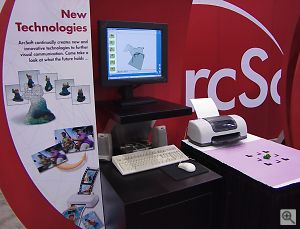 | ArcSoft's 3D Object Capture setup.
|
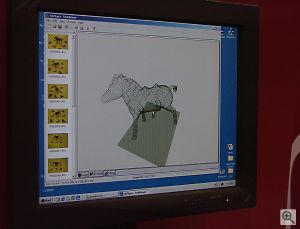 | Closeup of the interface.
|
Whilst ArcSoft were showing the results of their process as a 3D model both with and without textures, as well as the original source images used in the process, they weren't demonstrating the computational process, so we can't comment on its speed, accuracy or reliability just yet - but if it lives up to the promise of what we were shown, it really could make the process of creating 3D models (traditionally a laborious, time-consuming one) a whole lot easier...
 | The object and background.
|
Another program which ArcSoft is working on attempts to remove jitter or camera-shake from video captured with digital camcorders, using a combination of aligning frames, attempting to interpolate missing data in individual frames, and cropping the overall video. We were shown a before and after comparison of a video shot in Vietnam by an ArcSoft rep, and the results really were rather impressive. We did spot some artifacts of the process (likely from the interpolation), and some frames seemed to be skipped although we couldn't tell if that was from the process or the computer failing to keep up with playing the video - but overall the corrected video was much more watchable than the original. As is common with these things, we'd expect that hardware image stabilisation will remain dominant, since anything involving interpolation will degrade image quality to a certain extent - but in circumstances where the image stabilisation fails you ArcSoft's creation could come to your aid. We'd expect that the results will be significantly better if your source video is the best quality and the smoothest you could get it (gargage in, garbage out springs to mind)... The company couldn't give us a time-frame in which it expects either of its new software developments to reach the market.
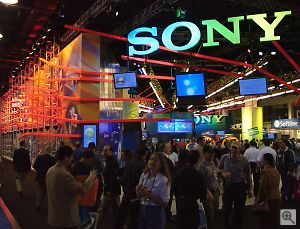 | Sony's booth.
|
Sony meanwhile had quite a presence at Comdex, between the company's huge and extremely busy booth (as you can see in our photo) which was probably rivalled only by that of software giant Microsoft, and a separate booth for its Memory Stick flash media cards and companies supporting the format. Quite a few concept products were on display between these two locations, and although many of these may never reach the marketplace, the technologies and ideas in them are likely to trickle down to the consumer over time.
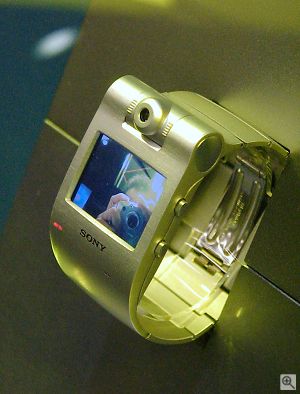 | The Two-Way Wrist Communicator.
|
Perhaps the most interesting of these concept products (at least, in our opinion) was located on the main Sony booth - the 'Two-Way Wrist Communicator'. A 137 gram wrist-watch style device, the Communicator features a 330,000 pixel (VGA) color imager, microphone and a 117,600 pixel 1.5-inch color LCD display, coupled with a Lithium Ion polymer battery. The watch 'body' has dimensions of 54 x 40.5 x 10.5 millimeters, and the watch is equipped with a wireless communication system (type and range unspecified) which allows transfer of the live video and audio to another device, 'Dick Tracy'-style. What particularly impressed us with this device was that it was more than just a wood-block concept, as the LCD was continually displaying a live video feed of what the camera was seeing (as always seems to be the way with our photos of this kind of thing, you can of course see your humble News Editor hiding behind a camera in the picture). :)
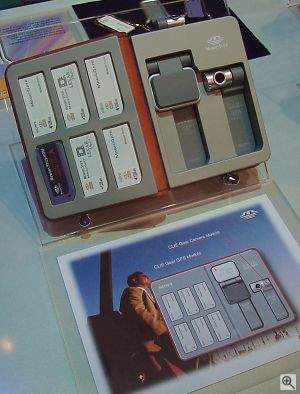 | CLIE Gear accessories.
|
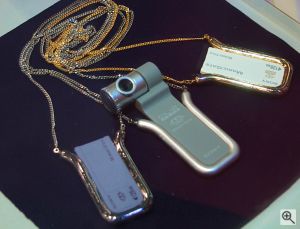 | Memory Stick necklace holders and camera.
|
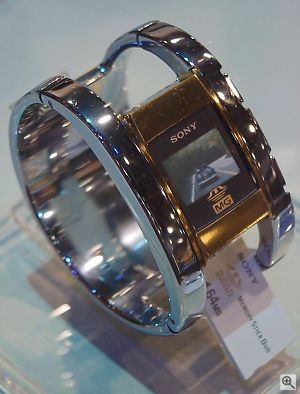 | Duo Cam Wristband.
|
A similar concept product, the 'Duo Cam Wristband', replaced the microphone and wireless connectivity of the Communicator with a slot for the diminutive Memory Stick Duo flash card, a product similar to the standard Memory Stick form factor but even smaller... As with the Communicator, the Duo Cam Wristband uses a Lithium Ion polymer battery. The Wristband also had significantly different, more 'futuristic' styling, and looked to be a 'proof of concept' mockup rather than a functioning prototype.
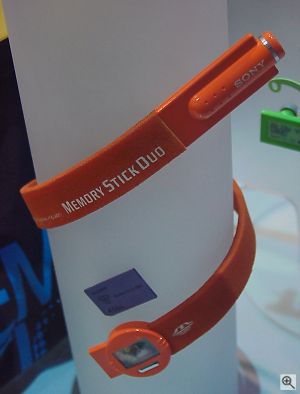 | Duo 'Snake' Digital Camera.
|
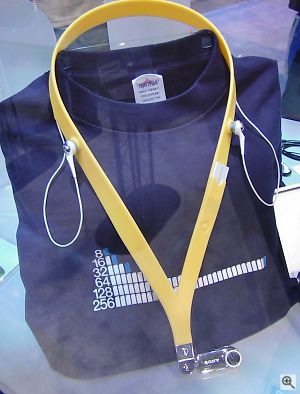 | Memory Stick Duo Multi-Player.
|
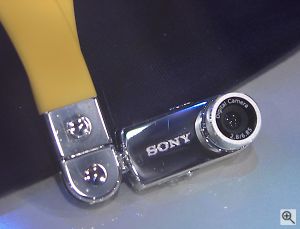 | Duo Multi-Player camera.
|
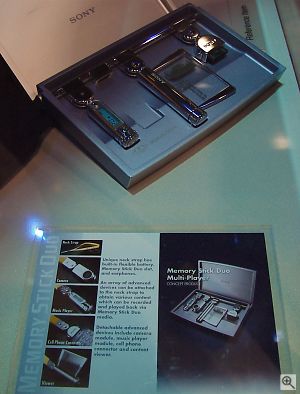 | Duo Multi-Player accessories.
|
Another mockup camera concept designed to be worn on the wrist (at least, we presume so!) is the rather bizarre 'Duo "Snake" Digital Camera', which consists of a camera lens on one end of a soft foam band which has a pliable (presumably metal) core that allows it to be twisted and retain its new shape wrapped around an object. On the other end of the band is a tiny LCD display and a shutter button, along with a slot for a Memory Stick Duo card on which to store images... The 'Memory Stick Duo Multi-Player' meanwhile consisted of a plastic neck-strap with a built-in flexible battery, Memory Stick Duo slot, and earphones along with a selection of interchangeable accessory modules that can be attached to the end of the strap (camera, music player, cell-phone connector and a transparent LCD viewer panel).
 | Sony's futuristic AIBO ERS-220.
|
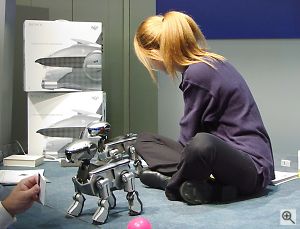 | Sony rep demonstrates AIBO.
|
As well as the many concept and prototype products, Sony was drawing crowds with its digital cameras and digital camcorders... The Cyber-shot DSC-F707 digital camera in particular seemed to be popular, and the company was also showing its newly-announced software for editing digital audio, video and still images (which we told you about in our ImageScape report). If we had to choose one item on Sony's booth that had visitors enthralled, though, it would have to be the AIBO robotic pet (the company is trying to get away from the term 'robotic dog', although that is still what it most looks like). AIBO was present in three variants; the button-cute ERS-311/312 'Latte' and 'Macaron' entry-level models, the ERS-210 which is apparently styled after a lion cub, and the just-announced ERS-220 (which in the opinion of this writer has robotic styling that looks just a little too 'lethal'!). OK, maybe they're not directly digital imaging-related, but the AIBO robots all feature cameras in their noses which allow them to 'see', and in the case of the latter two models also have wireless LAN abilities that allow you to have the robot take a snapshot of what it is looking at...
 | Crowds examine Sony's imaging products.
|
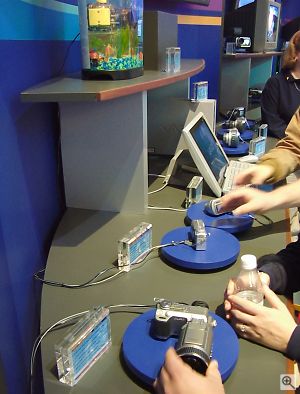 | Hands-on with Sony digicams.
|
One last point on Sony's booths was of interest. As far as we were aware, Sony's Memory Stick media was only manufactured by three companies - Lexar, SanDisk and of course Sony itself. On the Memory Stick Pavilion, though, we spotted a display (below) which showed Fujitsu and IO DATA Memory Sticks, as well as Memory Stick Duo cards under the Fujitsu badge. We also noticed Memory Stick Duo cards and MagicGate Memory Sticks with Lexar logos. We don't know whether Fujitsu and IO DATA have licenses to manufacture the cards, or even if they have signed licenses to sell rebadged cards. If their products are merely rebadged Sony cards this would have little effect; if the companies were able to make their own cards though (something Lexar currently does), this could potentially spur competition and lower prices.
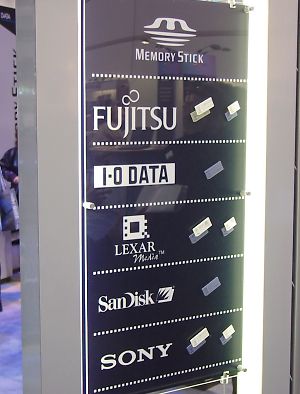 | Many flavors of Memory Stick.
|
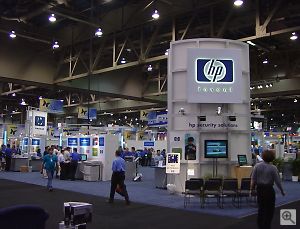 | Hewlett-Packard's booth.
|
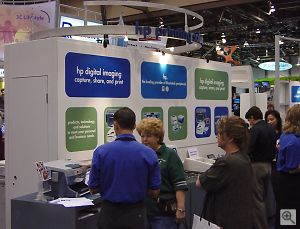 | Hewlett-Packard digital imaging products.
|
Another big name in imaging at Comdex was HP, which recently announced plans to purchase PC manufacturer Compaq (although objections from both the Hewlett and Packard families could see this deal fall through). The company had a wide range of printers on show, as well as several of its digital camera models. HP had an interesting approach in that rather than isolating the digital cameras on its stand as many others tend to, each camera was displayed alongside one of HP's printers, presumably with the intended effect of associating the two and using the cameras to push printer sales. (Printers and related supplies are one of HP's core product lines, so it makes sense that the company would use the cameras to back up the printer and media businesses...)
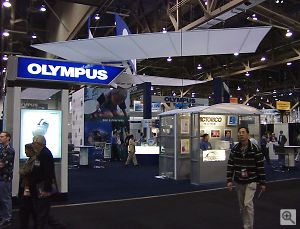 | Olympus' booth.
|
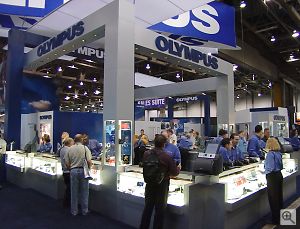 | A section of the Olympus booth.
|
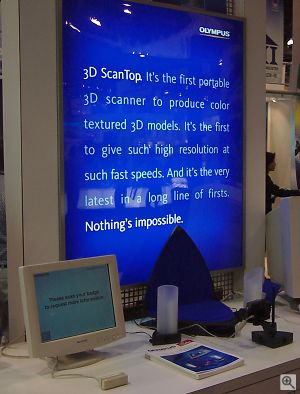 | 3D ScanTop display.
|
Olympus had a fairly sizeable booth on which it was showing a wide range of imaging products, including its printers and digital cameras. Two particularly interesting products were the 3D ScanTop kit and the Camedia Software Developer kit. The ScanTop kit consists of an automatic motor-driven turntable with backdrop that supports objects up to 7.87" wide, 9.8" tall and 6.6 lbs in weight, integrated camera stand and software-controlled HF lighting, calibration pattern, 3D ScanWare software and manual. Set up the software, connect the turntable and your camera to a computer, and the software handles the rest - automatically rotating the turntable, controlling lighting, and triggering the shutter. When done, the turntable collapses for easy carrying. A rather elegant solution, albeit for a fairly expensive $4000 - if you only need to create 3D models of small objects this could be worth considering. The Camedia Software Development kit, meanwhile, was mentioned in a display and has been used in the past for photo ID systems, 3D imaging, remote sensing and aerial photography. The kit is based on ActiveX, and offers 50 methods and properties to control Olympus cameras. Olympus also had a rather fun-looking demo for their EyeTrek goggles, with show visitors getting to play a racing game against each other whilst watching the race through their goggles.
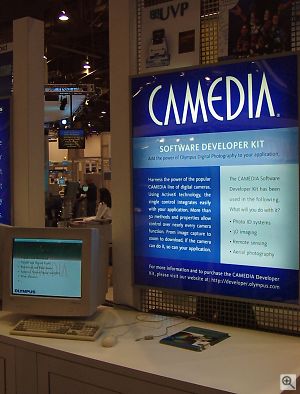 | Camedia SDK display.
|
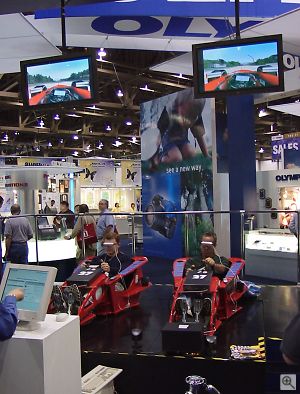 | Auto racing with the Olympus EyeTrek.
|
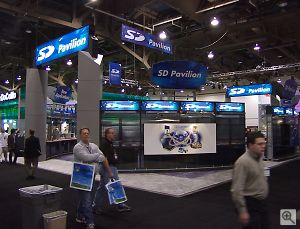 | Panasonic's SD Pavilion.
|
Similarly to Sony, Panasonic had separate booths for the company itself and for its flash media format. On the SD Pavilion, the company had plenty of products related to its Secure Digital format, but most of these are outside the scope of our coverage. A few did catch our eye, however - the 'SD Camera' being a mockup of a concept camera that plugs into a Secure Digital slot, and another display showing the almost identically named 'SD Camera Card', which really only had cosmetic differences (at least, no specs were given for either to suggest other differences). the NV-AP1 Digital Photo Printer was a working product, and could well be shipping or due to ship in Japan (we didn't recognize it, but it certainly it looked like a finished product; there were no booth reps around to question as we went past). The NV-AP1 features a 4" LCD screen, prints images up to 25 megapixels, and has dual SD card slots allowing images to be copied from card to card.
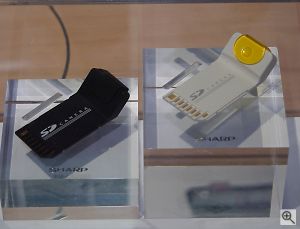 | The 'SD Camera'...
|
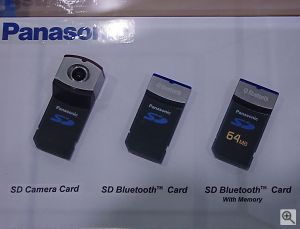 | ...and the almost identical 'SD Camera Card'.
|
On the main Panasonic booth, meanwhile, a poster listed details of Panasonic's plans for Secure Digital. SD cards currently top out at 128MB capacity and 2MB/second transfer speed, but the company plans to ship a 256MB card with a transfer speed of 10MB/second this year. Next year, this is predicted to expand to 1GB and a transfer speed of 20MB/second. The company doesn't specify a time-frame, but intends to follow the 1GB card with 2GB and 4GB capacities - pretty impressive if accomplished, in a card not much bigger than a postage stamp...
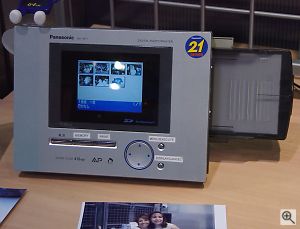 | NV-AP1 Digital Photo Printer.
|
That pretty much wraps up Part One of our Comdex report (a little over two thousand words!) - stay tuned for Part Two, coming soon...
UPDATED 2001-11-27 14:32ET: Want to read more? We've just posted Part Two of the Comdex Report, with lots of info on some of the Taiwanese manufacturers and some products you may not be familiar with...
|